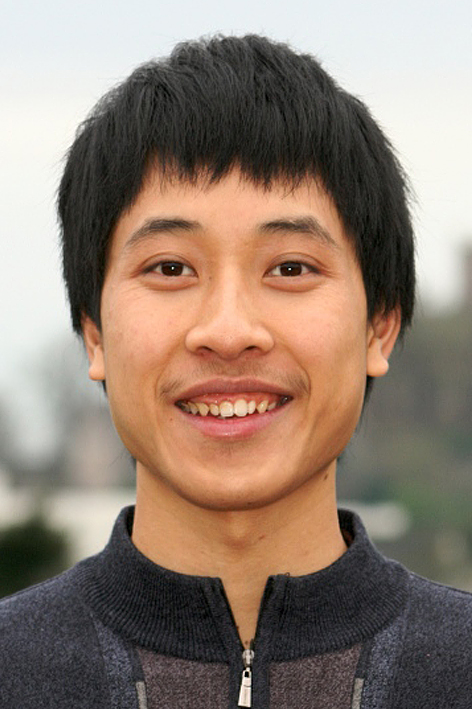
Name: Zhenghua Huang
Title: Postdoctoral Scientist
Address:School of Space Science and Physics, Shandong University,Weihai, Shandong, China, 264209 Email: huangzhenghua@gmail.com
Education
September 2009–July 2013: Ph.D. (subject: Solar Physics), Armagh Observatory/Queen’sUniversity Belfast, Armagh, UK.
Thesis title: ”Evolution of Bright Points, X-ray jets,their physical parameters and magnetic field
in and around Coronal Holes”
September 2006–June 2009: M.Sc. in Space Physics, University of Science andTechnology of China, Hefei, China. Received in June, 2009.
September 2002–July 2006: B.Sc. in Geophysics, University of Science and Technologyof China, Hefei, China. Received in July, 2006.
Research
Fields of Research Interest
Solar physics: observations of the source regions of the solar wind; how small-scaletransients in the solar atmosphere contribute to
the dynamic corona; non-LTE modellingof the solar atmosphere.
Research experience
September 2009–present:
(1) Study of small-scale transient brightenings (coronalbright points and X-ray jets) in and around coronal holes. The research uses observationsfrom
Solar Ultraviolet Measurement of Emitted Radiation (SUMER) aboard the Solarand Heliospheric Observatory (SOHO), Solar Optical Telescope (SOT),
X-ray Telescope(XRT) and Extreme-Ultraviolet Imaging Spectrometer (EIS) aboard Hinode to study thephysical parameters and magnetic evolution of
tens of the transient brightenings. This project produces two A&A publications and one conference proceeding article.
(2) Observational study of a GOES C4.3 flare with filament eruption. This work used observations from the Interferometric BIdimensional Spectrometer (IBIS)
and Rapid Oscillations inthe Solar Atmosphere (ROSA) installed on the Dunn Solar Telescope at the National Solar Observatory, and the Atmospheric
Imaging Assembly (AIA) and Helioseismic andMagnetic Imager (HMI) aboard the Solar Dynamics Observatory (SDO). This work is currently continuing.
(3) Take part in a study of “Statical Analysis of Small EllermanBomb Events”, which was using observations taken by IBIS, ROSA and HMI.
This workZhenghua Huang 2 has been submitted to Solar Physics.
(4) Take part in a numerical study of magneticreconnection resulting from flux emergence. This work has been published on A&A.
(5)Observation and modelling of the outflow region at the edge of active region. This work is a collaboration with a group in Denmark and is on-going.
(6) Begin to learn thenon-LTE radiation transfer calculation in the stellar atmosphere.
July 2005–July 2009: Used spectral observations taken by SOHO/SUMER to
(1) statistically study morphology and velocities of blinkers in the solar polar coronal holes;
(2) statistically analyse non-Gaussian line profiles from the emission in the solar transitionregion;
(3) measure the instrumental broadening of the detector B of Solar UltravioletMeasurement of Emitted Radiation.
These works had built up my M.Sc. and B.Sc.theses.
Observation experience
Have taken part in an observational project in National Solar Observatory at Sac PeakNew Mexico for 10 days.
Publications
1. Z. Huang, M. S. Madjarska, J. G. Doyle, D. A. Lamb, “Coronal hole boundaries at smallscales: IV. SOT view.
Magnetic field properties ofsmall-scale transient brightenings in coronal holes”, 2012, A&A, 548, A62, 19 pages.
2. M. S. Madjarska,Z. Huang, J. G. Doyle, S. Subramanian, “Coronal hole boundariesevolution at small scales–III. EIS
and SUMER views”, 2012, A&A, 545, A67, 16 pages
3. Z. Huang, M. S. Madjarska, J. G. Doyle, D. A. Lamb, “Evolution of magnetic field corresponding to X-ray
brightening events in coronal holes and quiet Sun”, 2012, Proceedings of IAU Symposium No. 294, 2013, 155.4. C. J. Nelson, J. G. Doyle, R. Erd´elyi,Z. Huang, M. S. Madjarska, M. Mathioudakis,S. J. Mumford, K. Reardon,
“Statistical Analysis of Small Ellerman Bomb Events”, 2013, Solar Physics, 283, 307–323.
5. J. Y. Ding, M. S. Madjarska J. G. Doyle, Q.-M. Lu, K. Vaninathan,Z. Huang, “Magneticreconnection resulting
from flux emergence:implications for jet formation in the lower solar atmosphere?” 2011, A&A, 535, A95, 11 pages.Conference contributions
1. “Evolution of magnetic field corresponding to X-ray brightening events in coronal holesand quiet Sun”,
poster on the IAU XXVIII General Assembly Symposium No. 294, Beijing, August 2012.
2. “Observations of a GOES C4.3 flare with filament eruption in the love heart of AR11123:tracking from chromosphere
to corona”, poster on the 13 th European Solar Physics Meeting, Rhodes, September 2011.Zhenghua Huang 3
3. “Observations of a coronal hole bright point with Hinode/EIS, XRT, SOT and SOHO/SUMER”,poster on RAS NAM 2010,
Glasgow, April 2010.
Public talks
“Coronal hole boundaries at small-scales: observations from lower chromosphere to corona”,
seminar at Center for Space Science and Applied Research, Chinese Academy Of Sciences,Beijing, August 30 2012.
Public outreach
1. “Solar activities: from the large to small scale”, introduction talk for University CollegeDublin Evening Class members, Armagh Observatory, February 26 2011.
2.“The Sun interacts with the Earth through electromagnetic radiation and the solar wind”,introduction talk for a group of
undergraduate students from University College Dublin, Armagh Observatory, March 13 2010.
3.Assist senior staffof the Armagh Observatory to carry out many public outreach activities, such as tours,
lectures etc. during 2009–2012.
Computer and programming skills
1. Experienced in IDL and solar software (SSW) packages; Familiar with C, Fortran, HTML,and Matlab.
2. Familiar with an image reconstruction package, Speckle, and a feature tracking package,SWAMIS.
Honors, Awards, & Fellowships
1. The PhD studentship is rewarded by the Department of Culture, Art, and Leisure ofNorthern Ireland, 2009. This studentship support my PhD study at ArmaghObservatory from 2009 till now.
2. Outstanding undergraduate of Anhui province, rewarded by the Education departmentof Anhui province, 2006.
3. Anhui “SiChuang” award for top range students of the year, rewarded by the Universityof Science and Technology of China, 2005.
4. Silver award of outstanding students of the year, rewarded by the University of Scienceand Technology of China, 2004.
